Abstract
The Alborz mountain range in northern Iran is part of the active and seismic Alpide belt, where assessing seismic hazards is crucial due to the region’s history of large instrumental earthquakes and destructive seismic background. Moment rate estimation, which quantifies tectonic activity, offers a novel approach to understanding the energy potential of active tectonic regions. In this study, a regional perspective is employed to investigate the maximum horizontal acceleration for Tehran, the major city in Alborz, resulting from the Sorkh-e Hesar and Ghasr-e-Firuzeh faults located approximately 7.5 km southeast of Tehran. These faults have a seismic potential of Mw 6.5 and a gravity of ~0.5723. While previous studies have identified faults in northern Tehran as the greatest seismic risk, our findings suggest otherwise. The calculated geological moment was 5.18218 × 1017 Nm/y, with a seismic moment rate of 1.83375 × 1014 Nm/y, providing valuable insights into fault activity and seismic potential in the study area.
1. Introduction
The stress resulting from the continuous movements of the Earth’s crust plates, specifically the Arabian and Eurasian plates, is a primary driver of seismic activity in Iran, leading to the formation of distinctive geological structures in various sub-zones, including the Alborz mountain range (Figure 1). The Alborz region encompasses major cities such as Tehran, Rasht, Karaj, Zanjan, Qazvin, Sari, and Gorgan, which have experienced devastating historical earthquakes. The mechanism and density of faults in the Alborz mountain range significantly affect its seismicity parameters. Therefore, a thorough examination of these seismic parameters can provide valuable insights into the seismicity of these cities, particularly Tehran, the capital of Iran, in terms of the magnitude and timing of potential future earthquakes.
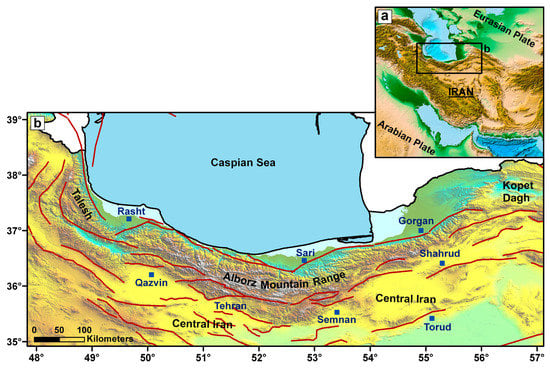
Figure 1.
Location of the study area: (a) Depicts the northern region of Iran and the southern area of the Caspian Sea on a smaller scale, providing a general overview of the study area’s geographic context. (b) Illustrates the specific location of the study area in greater detail, showcasing names and positions of cities, along with identification of the main faults.
It is important to note that deformations resulting from stress can propagate and impact surrounding areas. Movements in one area can create deformations in adjacent regions, highlighting the interconnectedness of seismic activity in the Alborz region. As such, a holistic approach that considers all active faults and their hazards in relation to a specific point, such as Tehran city, can facilitate a more comprehensive analysis of seismic risks in different parts of the Alborz zone.
Understanding the seismic hazards and risks in the Alborz region, including its major cities, is of paramount importance for earthquake risk mitigation and disaster preparedness efforts. By examining the seismic parameters and taking into account the complex interplay of various factors, such as fault mechanisms, fault density, and regional deformation patterns, we can improve our understanding of the seismicity of the region and make informed decisions for disaster planning, infrastructure development, and public safety measures. This study aims to contribute to this understanding by employing a regional perspective to investigate the maximum horizontal acceleration for Tehran, the capital of Iran, resulting from specific faults in the Alborz region, and provide valuable insights into fault activity and seismic potential in the study area. The geological moment rate is considered an aggregate of the crustal deformation, including the plastic and elastic components. Comparing seismic and geologic data helps to illustrate areas where all deformation rates are related to the crustal seismicity with some physical uncertainties [1,2,3,4].
Furthermore, it is possible to consider regions with high seismic deformation rates and interseismic slip across the faults [5,6,7,8,9]. Therefore, a joint effort to assess the number of large missing earthquakes is required to balance the moment released by seismicity [1,2,7]. In this study, we describe the calculation of geological moment rates from all active faults by presenting the relevant relations and the assumed values. We justify our preliminary selection of moment-rate models, describe the steps taken to constrain the seismicity rates to be consistent with observations, and provide the reasoning for not including seismicity rates from fault strain rates for the PGA map.
2. Tectonic Setting and Seismicity
The Alborz mountain range is an intercontinental fold–thrust belt of about 1000 km in length and a width of about 500 km with an approximate east–west trend within the Alpine-Himalayan orogenic belt (Figure 1). The Alborz, located on the boundary between the Turan–Ural Platform and the Central Iranian Subcontinent, is the northernmost deformation zone resulting from the convergence of the Arabian and Eurasian Plates. The study area is located in the north of Iran and between the latitude of ~35°01′ N–38°48′ N and the longitude of 56°59′ E–48°01′ E (Figure 1). In seismically active regions is always a relationship between the identified active faults and the earthquakes in terms of location and depth. Thus, the study of characteristics of the active faults can be the basis for seismic surveys of a region. In the Alborz region, the active faults, which usually cut the Quaternary units, have been marked on the geological maps (scales; 1:250,000, 1:100,000) and satellite imagery in various international articles [10,11,12] (Figure 2).
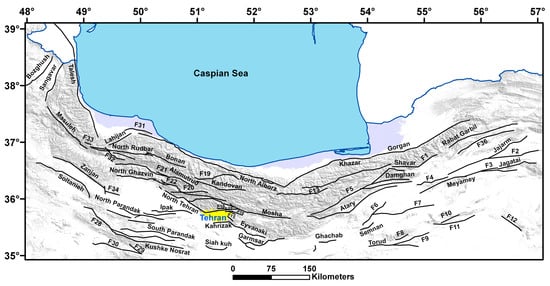
Figure 2.
Active faults of Alborz in northern Iran [13,14].
The main active faults of the Alborz with a dominant component of thrust surround the area from the north (e.g., North Alborz, Khazar SSW-dipping faults) to the south (e.g., Garmsar, North Tehran, Jajarm, Pishva N-dipping faults), while the strike-slip movement is concentrated inside the range (e.g., Rudbar, Firuzkuh, Mosha) [14,15,16,17].
In certain regions of the Earth, significant seismic activity has been observed, including past occurrences of large earthquakes, as documented by [18,19,20,21]. Understanding historical seismic events and their locations is crucial for conducting seismic hazard analysis, as emphasized by [22]. This study has compiled and examined historical earthquake data from various sources, such as books and articles [23,24].
The seismicity of each structural zone has been studied over two periods: the pre—20th century (pre-instrumental) period and the instrumental period that followed the development of seismic instruments in the late 19th century. Figure 3 and Table 1 and Table 2 provide information on instrumental and historical earthquakes in the study area. The region has experienced several significant instrumental earthquakes, such as the 1935 Mw 6.8 Kusut, 1953 Mw 6.5 Troud, 1957 Mw 7 Sangchal, 1962 Mw 7.2 Buin-Zahra, 1980 Mw 6.6 Shirabad, 1990 Mw 7.3 Rudbar, 2002 Mw 6.5 Avaj, and 2004 Mw 6.4 Baladeh earthquakes, resulting in considerable economic and human losses, as reported by [23,25,26,27].
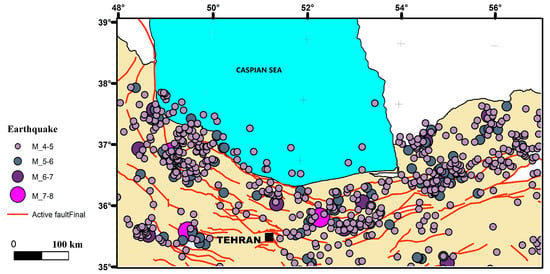
Figure 3.
The instrumental earthquake epicenter of the Alborz mountain range and its surrounding areas.

Table 1.
Active faults [13,14] of the study area with the active fault type (T), fault length (L), and nearest fault distance to Tehran (R).

Table 2.
Historical earthquakes in the study area. M = Magnitude, q = The quality of determining the location of the center of the earthquake, i0 = The intensity of the earthquake in the center, r = Radius of perceptibility, r′ = Epicenter distance, Ref. = Reference, A = Ambraseys and Melville, 1982, B = Berberian and Yeats, 1999.
The historical sites in the immediate southern foothills of the Central Alborz, particularly around Tehran, have been devastated multiple times by historical earthquakes, as noted by [23,26]. The Eivanaki, North Tehran, and Rey faults have been identified as sources of historical earthquakes, occurring in 1384 AD, 1177 (Ms 7.2), 855 (Ms 7.1), 743 (Ms 7.2), and 312–280 BC (Ms 7.6), as reported by [23,26]. Thus, considering the current population of approximately 13 million, Tehran may face significant seismic hazards.
3. Results and Discussion
The Gutenberg–Richter [28] method is a widely used mathematical approach for describing the seismicity of a region. This method involves investigating the seismic state of the region and defining the magnitude–frequency relationship of earthquake events. The constant coefficients in this equation provide insights into the different levels of seismicity in the area. The equation for the Gutenberg–Richter method is represented as:
where Nc represents the cumulative frequency of earthquakes, a and b are constant coefficients (with a denoting the number of earthquakes and b denoting the relative frequency of earthquakes with different magnitudes), and Ms indicates the magnitude of the earthquakes. For this study, earthquakes with a magnitude of Ms ≥ 3 that occurred over 120 years (from 1900 to 2020) in the Alborz mountain range were selected. By plotting the graph of Log N − Ms, the seismic parameters of the region (a and b) were obtained (Figure 4). According to the seismic formula obtained for the region (Figure 4), the values of the seismic parameters were determined as a = 1.832508913 and b = 0.6918.
Log Nc = a − bMs
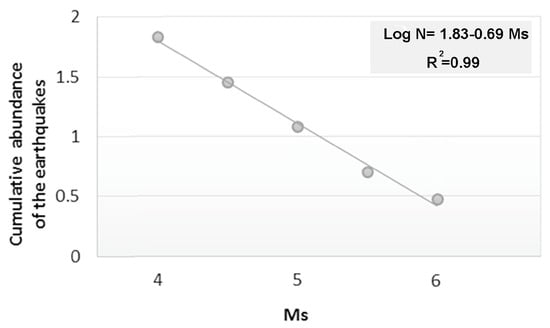
Figure 4.
Graph of Log N − Ms in order to calculate the seismic formula of the region using the Gutenberg–Richter method.
The earthquake return period formula can be used to calculate the time of occurrence of two similar events. The average time interval between a given event and a more significant event or equivalent is called the return period (T), which is calculated from the following relation [29]:
where N is the number of earthquakes of equal or greater magnitude than the one of interest that occurred during the time period of interest. According to Equation (1), the average return period for earthquakes in the Alborz region can be calculated using the following Equation (3):
where M is the magnitude of the earthquake. The return period of earthquakes in the Alborz region is calculated and presented in Table 3.
T = 1/N
T = 10^(−a + bM)

Table 3.
Estimates of the earthquake return period (T) with different magnitudes (Ms) in the region (based on [30]). N represents the cumulative frequency of earthquakes, while a and b are constant coefficients.
Horizontal ground acceleration rates are typically chosen based on two possible boundaries: 10% and 64% [31]. The limit of 10% represents the maximum credible earthquake (MCE), which is the highest magnitude earthquake that can be expected to occur within the next 50 years, with a probability of 10% or less. The limit of 64% represents the design basis earthquake (DBE), which is the earthquake that can be expected to occur within the next 50 years with a probability of 64%. These parameters can be calculated using the relations proposed by Trifunac and Brady [32]. The equation used to calculate the probability of exceedance for a given return period (Rp) is:
where T is the return period in years, Ms is the earthquake magnitude, and a and b are the coefficients obtained from the Gutenberg–Richter relation.
Rp = 1 − exp(−T × 10^(a − bMs))
Therefore, the equation used to calculate the DBE is:
and the equation used to calculate the MCE is:
0.64 = 1 − exp(−T × 10^(a − bMs))
0.1 = 1 − exp(−T × 10^(a − bMs))
For the region, the DBE and MCE were calculated to have a useful life of 10 to 100 years (Table 4).

Table 4.
Estimates of DBE and MCE for a useful life of 10 to 230 years.
The ground motion parameters, such as velocity, acceleration, and displacement in the vertical and horizontal directions at the earthquake epicenter, were estimated using the formulas proposed by [31]. Additionally, various formulas, including some from [30,32,33,34], were used to calculate the relationship between fault length (L) and earthquake magnitude (Ms) in the study area. These formulas were employed to estimate the seismic potential of the faults, and the calculations are presented in Table 5.

Table 5.
Surface rupture length (SRL) in meters, rupture width (WR) in meters, and rupture area (AR) in square meters of each earthquake by the fault activities. Ms (Av) is the mean magnitude.
Donovan [34] studied 670 acceleration maps from various countries, including 100 from Japanese earthquakes and 210 from California. From this analysis, he proposed Equation (7) to calculate the maximum acceleration of gravity:
Y = 1.320 exp(0.58 Mb)/(R + 25)^1.52
Additionally, Campbell [35] provided Equation (8) for shallow earthquakes with magnitudes ranging from 5 to 7.7 and distances of less than 50 km between the earthquake source and the site, considering solid rock or alluvial sediments:
Y = 0.0159 exp(0.868 M) [R + 0.0606 exp(0.7 M)]^−1.09
Equations (7) and (8) were used to calculate the maximum horizontal ground acceleration due to gravity in the study area, and the results are presented in Table 6. A network of 1565 points in the study area was analyzed to generate the seismic hazard map. Fault lengths were calculated using the X-Tools lateral extension in the ArcGIS software 10.6, and the distances between each fault and the center of each point were determined using the ArcView software. The PGA values were then interpolated and mapped to the PGA points, as shown in Figure 5. The Qasr-e Firuzeh and Sorhk-e Hear fault systems (F14), located approximately 7.5 km southeast of Tehran, were found to have a seismic magnitude of 6.3 Richter and a gravity acceleration of 0.55723 g.

Table 6.
The maximum ground acceleration (PGA) of each fault in the area. DT = Distance to Tehran.
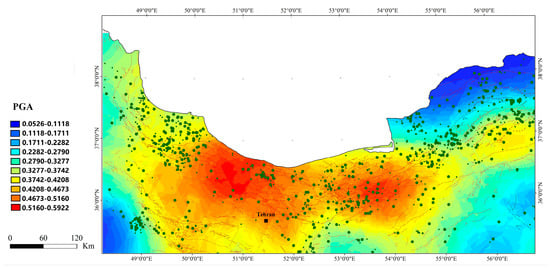
Figure 5.
The seismic hazard map of the area. The Central Alborz and the western part of the Eastern Alborz show high seismic hazards.
As per Zolfaghari’s research [36], higher seismic slip rates have been observed on the western side of the Central Alborz and the west side of the Eastern Alborz depicted. This suggests that the probability of a large earthquake occurring in these regions with high slip rates is higher than in other areas. This observation aligns with the seismic hazard map generated in the current study (Figure 5). Additionally, considering the seismic and geodetic strain, as well as the moment rates from the research [14], it is evident that the Central Alborz region, where major faults such as the North Alborz fault exist, poses a significant seismic hazard.
On the one hand, the comparison of the amount and the stress vectors of the dynamic fault structures of the Central Alborz shows a drop in the stress rate and a sudden loss of nearly 1 MM/y from the slip rate seen on eastern faults such as the Astana fault [37]. Firouzkoh fault [38], and Mosha fault [39] compared to the Taleghan fault [40] and North Tehran fault [41] on the western side. Considering that deformation and stress were previously estimated from geodetic measurements [42,43] in the Central Alborz area, unlike Zagros, it is considered to have more seismic nature, so it is possible that 1 mm of missing shear stress is accumulating in the central part of the Mosha fault or the eastern part of the fault zone north of Tehran; in other words, this part of the Mosha fault could be a single fault. It can be considered locked with a relatively high probability of seismic failure in the future evolution of its tectonic earthquake [44]. Also, according to the results of this research, which estimates the risks of the eastern faults of Tehran to be higher, it seems that the studies of [38,44,45,46] also confirm the same opinion. This study argues that the Sorkh-e Hesar and Ghasr-e Firuzeh fault systems include a system that has not been introduced and show that we need to focus on the Mosha–Parchin system in studies, so according to the results of this study, the shown stress accumulation in this fault system can be attributed to the fault locking of this system northeast, east, and southeast of Tehran and the high seismic potential in this fault that ought to be the focus of studies.
To calculate the geological moment rate, several parameters including fault length, fault dip, fault slip rate, and thickness of the seismic layer in the region are required. Assuming a constant seismic layer thickness throughout the seismotectonic zone, the seismic moment rate can be obtained using Equation (9) [47]:
where µ is the shear coefficient (with a value of 3 × 10^10 N/m2), Li is the fault length, Si is the fault slip rate, δı is the fault dip, and Hs is the seismic thickness. In this study, considering the depth of the Alborz earthquakes, a seismic layer thickness of 18 km was assumed, and the absolute value of the cosine function was used to ensure that the calculation is positive. Consequently, the geological moment for each main fault (Table 7) and the average geological moment for the region (~5.18218 × 1017 Nm/y) were calculated. Based on the calculations, the Eshkabad, Taleqan, and Mayamey faults exhibit the highest geological moment rates (Table 7; Figure 6).
M = µ ∑ (Li.Hs.Si)/|Cos δı|

Table 7.
Geological moments of major faults in the region categorized by fault type: T = Thrust, SS = Strike-slip, N = Normal, SS-T = Strike-slip with Thrust, T-SS = Thrust with Strike-slip, RS = Reverse-Slip, T-RS = Thrust with Reverse-Slip.
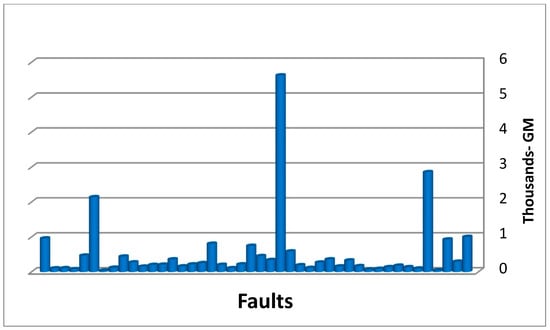
Figure 6.
Bar graph illustrating the geological moments of the primary faults in the region (refer to Table 7). The Eshqabad, Taleqan, and Mayamey faults exhibit the highest geological moment (GM) values.
4. Conclusions
In conclusion, our study reveals that northern Iran, particularly the Central Alborz, is a highly active region in terms of seismicity. Our findings highlight the high risk of significant earthquakes in Tehran, Alborz, and Qazvin, given the long recurrence period of earthquakes with magnitudes greater than 6. Therefore, cities in high-risk areas, specifically the western side of the Central Alborz and the western side of the Eastern Alborz, are at the highest seismic risk due to their proximity to fault zones.
The seismic hazard map generated in this study provides valuable information to mitigate the potential damage caused by future earthquakes. The estimated maximum horizontal acceleration for Tehran due to the Qasr-e Firuzeh and Sorhk-e Hesar fault systems is 0.5757, with a seismic potential of 6.3 Richter. These findings have significant implications for the region’s urban planning, building design, and emergency response strategies.
Furthermore, the geological moment rates, encompassing both seismic and aseismic deformations, provide insight into the potential of faults to release the stored elastic energy in the crustal rocks of the region. Our study identified the Eshqabad, Taleqan, and Mayamey faults as exhibiting the region’s highest geological moment rates. These findings can aid in understanding the potential for future earthquakes and inform seismic hazard assessments in the area.
In summary, our study highlights the need for continued monitoring and evaluation of seismic hazards in northern Iran to improve earthquake preparedness and mitigate potential damage to infrastructure and communities in the region.
Author Contributions
Conceptualization, A.M.N. and A.R; methodology, M.M.K. and S.M; software, A.M.N. and A.R; validation, M.N., S.S. and R.D.; formal analysis, S.S. and R.D; investigation, A.M.N. and A.R.; resources, R.D.; data curation, S.S.; writing—original draft preparation, A.M.N. and A.R; writing—review and editing, A.R. and R.D; visualization, M.N.; supervision, M.M.K. and A.R.; project administration, A.M.N. and S.M.M. All authors have read and agreed to the published version of the manuscript.
Funding
This research received no external funding.
Institutional Review Board Statement
Not applicable.
Informed Consent Statement
Not applicable.
Data Availability Statement
Data are contained within the article.
Acknowledgments
This work is the result of a collaborative research study involving the Department of Geology at the University of Birjand, Iran; the Department of Earthquake Research at Shahid Bahonar University of Kerman, Iran; the International Institute of Earthquake Engineering and Seismology in Tehran, Iran; the Department of Geology at Shahid Bahonar University of Kerman, Iran; and the Department of Earth Sciences at Utrecht University, The Netherlands.
Conflicts of Interest
The authors declare no conflict of interest.
References
- Mazzotti, S.; Leonard, L.J.; Cassidy, J.F.; Rogers, G.C.; Halchuk, S. Seismic Hazard in Western Canada from GPS Strain Rates versus Earthquake Catalog. J. Geophys. Res. Solid. Earth 2011, 116. [Google Scholar] [CrossRef]
- Pancha, A.; Anderson, J.G.; Kreemer, C. Comparison of Seismic and Geodetic Scalar Moment Rates across the Basin and Range Province. Bull. Seismol. Soc. Am. 2006, 96, 11–32. [Google Scholar] [CrossRef]
- D’Agostino, N.; Mantenuto, S.; D’Anastasio, E.; Avallone, A.; Barchi, M.; Collettini, C.; Radicioni, F.; Stoppini, A.; Fastellini, G. Contemporary Crustal Extension in the Umbria–Marche Apennines from Regional CGPS Networks and Comparison between Geodetic and Seismic Deformation. Tectonophysics 2009, 476, 3–12. [Google Scholar] [CrossRef]
- Derakhshani, R.; Eslami, S.S. A New Viewpoint for Seismotectonic Zoning. Am. J. Environ. Sci. 2011, 7, 212–218. [Google Scholar] [CrossRef]
- Delvaux, D.; Maddaloni, F.; Tesauro, M.; Braitenberg, C. The Congo Basin: Stratigraphy and Subsurface Structure Defined by Regional Seismic Reflection, Refraction and Well Data. Glob. Planet. Change 2021, 198, 103407. [Google Scholar] [CrossRef]
- Déprez, A.; Doubre, C.; Masson, F.; Ulrich, P. Seismic and Aseismic Deformation along the East African Rift System from a Reanalysis of the GPS Velocity Field of Africa. Geophys. J. Int. 2013, 193, 1353–1369. [Google Scholar] [CrossRef]
- Stevens, V.L.; Avouac, J.P. Millenary Mw > 9.0 Earthquakes Required by Geodetic Strain in the Himalaya. Geophys. Res. Lett. 2016, 43, 1118–1123. [Google Scholar] [CrossRef]
- Bos, A.G.; Spakman, W. Kinematics of the Southwestern US Deformation Zone Inferred from GPS Motion Data. J. Geophys. Res. Solid. Earth 2005, 110. [Google Scholar] [CrossRef]
- Palano, M.; Imprescia, P.; Agnon, A.; Gresta, S. An Improved Evaluation of the Seismic/Geodetic Deformation-Rate Ratio for the Zagros Fold-and-Thrust Collisional Belt. Geophys. J. Int. 2018, 213, 194–209. [Google Scholar] [CrossRef]
- Javidfakhr, B.; Bellier, O.; Shabanian, E.; Siame, L.; Léanni, L.; Bourlès, D.; Ahmadian, S. Fault Kinematics and Active Tectonics at the Southeastern Boundary of the Eastern Alborz (Abr and Khij Fault Zones): Geodynamic Implications for NNE Iran. J. Geodyn. 2011, 52, 290–303. [Google Scholar] [CrossRef]
- Rashidi, A. Geometric and Kinematic Characteristics of the Khazar and North Alborz Faults: Links to the Structural Evolution of the North Alborz-South Caspian Boundary, Northern Iran. J. Asian Earth Sci. 2021, 213, 104755. [Google Scholar] [CrossRef]
- Nazari, H.; Ritz, J.-F.; Burg, J.-P.; Shokri, M.; Haghipour, N.; Vizheh, M.M.; Avagyan, A.; Nashli, H.F.; Ensani, M. Active Tectonics along the Khazar Fault (Alborz, Iran). J. Asian Earth Sci. 2021, 219, 104893. [Google Scholar] [CrossRef]
- Hessami, K.; Mobayyen, F.; Tabassi, H. The Map of Active Faults of Iran; International Institute of Earthquake Engineering and Seismology Tehran: Tajrish, Iran, 2013. [Google Scholar]
- Sheykholeslami, M.R.; Javadi, H.R.; Asadi, M. Iran Fault Map on Provincial Subdivisions; Geological Survey & Mineral Explorations of Iran (GSI): Tehran, Iran, 2013. [Google Scholar]
- Rashidi, A.; Derakhshani, R. Strain and Moment Rates from GPS and Seismological Data in Northern Iran: Implications for an Evaluation of Stress Trajectories and Probabilistic Fault Rupture Hazard. Remote Sens. 2022, 14, 2219. [Google Scholar] [CrossRef]
- Trifonov, V.G.; Hessami, K.; Popov, S.V.; Zelenin, E.A.; Trikhunkov, Y.I.; Frolov, P.D.; Golovina, L.A.; Simakova, A.N.; Rashidi, A.; Latyshev, A.V. Development of the Southern Coastal Area of the Caspian Sea during the Pliocene–Quaternary According to Biostratigraphic and Magnetostratigraphic Data. Stratigr. Geol. Correl. 2022, 30, 273–291. [Google Scholar] [CrossRef]
- Nikpeyman, Y.; Nikpeyman, V.; Derakhshani, R.; Raoof, A. Assessment of a Multi-Layer Aquifer Vulnerability Using a Multi-Parameter Decision-Making Method in Mosha Plain, Iran. Water 2022, 14, 3397. [Google Scholar] [CrossRef]
- Rashidi, A.; Kianimehr, H.; Shafieibafti, S.; Mehrabi, A.; Derakhshani, R. Active Faults in the West of the Lut Block (Central Iran). Geophys. Res. 2021, 22, 70–84. [Google Scholar] [CrossRef]
- Rashidi, A.; Kianimehr, H.; Yamini-Fard, F.; Tatar, M.; Zafarani, H. Present Stress Map and Deformation Distribution in the NE Lut Block, Eastern Iran: Insights from Seismic and Geodetic Strain and Moment Rates. Pure Appl. Geophys. 2022, 179, 1887–1917. [Google Scholar] [CrossRef]
- Ezati, M.; Rashidi, A.; Gholami, E.; Mousavi, S.M.; Nemati, M.; Shafieibafti, S.; Derakhshani, R. Paleostress Analysis in the Northern Birjand, East of Iran: Insights from Inversion of Fault-Slip Data. Minerals 2022, 12, 1606. [Google Scholar] [CrossRef]
- Ezati, M.; Gholami, E.; Mousavi, S.M.; Rashidi, A.; Derakhshani, R. Active Deformation Patterns in the Northern Birjand Mountains of the Sistan Suture Zone, Iran. Appl. Sci. 2022, 12, 6625. [Google Scholar] [CrossRef]
- Kamali, Z.; Nazari, H.; Rashidi, A.; Heyhat, M.R.; Khatib, M.M.; Derakhshani, R. Seismotectonics, Geomorphology and Paleoseismology of the Doroud Fault, a Source of Seismic Hazard in Zagros. Appl. Sci. 2023, 13, 3747. [Google Scholar] [CrossRef]
- Mehrabi, A.; Pirasteh, S.; Rashidi, A.; Pourkhosravani, M.; Derakhshani, R.; Liu, G.; Mao, W.; Xiang, W. Incorporating Persistent Scatterer Interferometry and Radon Anomaly to Understand the Anar Fault Mechanism and Observing New Evidence of Intensified Activity. Remote Sens. 2021, 13, 2072. [Google Scholar] [CrossRef]
- Ambraseys, N.N.; Melville, C.P. A History of Persian Earthquakes; Cambridge University Press: Cambridge, UK, 1982; ISBN 0521021871. [Google Scholar]
- Berberian, M. Natural Hazards and the First Earthquake Catalog of Iran, Volume 1: Historical Hazards in Iran Prior to 1900. Int. Institue Earthq. Eng. Seismol. 1994, 1, 603. [Google Scholar]
- Berberian, M.; Yeats, R.S. Contribution of Archaeological Data to Studies of Earthquake History in the Iranian Plateau. J. Struct. Geol. 2001, 23, 563–584. [Google Scholar] [CrossRef]
- Berberian, M.; Yeats, R.S. Patterns of Historical Earthquake Rupture in the Iranian Plateau. Bull. Seismol. Soc. Am. 1999, 89, 120–139. [Google Scholar] [CrossRef]
- Tchalenko, J.S. Seismotectonic Framework of the North Tehran Fault. Tectonophysics 1975, 29, 411–420. [Google Scholar] [CrossRef]
- Gutenberg, B.; Richter, C.F. Magnitude and Energy of Earthquakes. Ann. Geophys. 1956, 9, 795. [Google Scholar] [CrossRef]
- Nowroozi, A.A.; Ahmadi, G. Analysis of Earthquake Risk in Iran Based on Seismotectonic Provinces. Tectonophysics 1986, 122, 89–114. [Google Scholar] [CrossRef]
- Pourkermani, M.; Arian, M. Seismotectonics; Dez Ab Consulting Engineers Company Press: Tehran, Iran, 1997. [Google Scholar]
- Trifunac, M.D.; Brady, A.G. On the Correlation of Seismic Intensity Scales with the Peaks of Recorded Strong Ground Motion. Bull. Seismol. Soc. Am. 1975, 65, 139–162. [Google Scholar]
- Tocher, D. Movement on Faults. In Proceedings of the Second World Conference on Earthquake Engineering, Tokyo, Japan, 11–18 July 1960; Volume 1, pp. 551–564. [Google Scholar]
- Nowroozi, A.A.; Mohajer-Ashjai, A. Fault Movements and Tectonics of Eastern Iran: Boundaries of the Lut Plate. Geophys. J. Int. 1985, 83, 215–237. [Google Scholar] [CrossRef]
- Donovan, N.C. A Statistical Evaluation of Strong Motion Data: Including the February 9, 1971 San Fernando Earthquake; Dames & Moore: San Francisco, CA, USA, 1973. [Google Scholar]
- Campbell, K. Near-Source Attenuation of Peak Horizontal Acceleration. Bull. Seismol. Soc. Am. 1981, 71, 2039–2070. [Google Scholar]
- Zolfaghari, M.R. Geodetic Deformation vs. Seismic Strain Deduced by Historical Earthquakes across the Alborz Mountains. J. Seismol. 2009, 13, 647–663. [Google Scholar] [CrossRef]
- Rizza, M.; Mahan, S.; Ritz, J.F.; Nazari, H.; Hollingsworth, J.; Salamati, R. Using Luminescence Dating of Coarse Matrix Material to Estimate the Slip Rate of the Astaneh Fault, Iran. Quat. Geochronol. 2011, 6, 390–406. [Google Scholar] [CrossRef]
- Nazari, H.; Ritz, J.F.; Walker, R.T.; Salamati, R.; Rizza, M.; Patnaik, R.; Hollingsworth, J.; Alimohammadian, H.; Jalali, A.; Kaveh Firouz, A.; et al. Palaeoseismic Evidence for a Medieval Earthquake, and Preliminary Estimate of Late Pleistocene Slip-Rate, on the Firouzkuh Strike-Slip Fault in the Central Alborz Region of Iran. J. Asian Earth Sci. 2014, 82, 124–135. [Google Scholar] [CrossRef]
- Ritz, J.-F.; Nazari, H.; Ghassemi, A.; Salamati, R.; Shafei, A.; Solaymani, S.; Vernant, P. Active Transtension inside Central Alborz: A New Insight into Northern Iran–Southern Caspian Geodynamics. Geology 2006, 34, 477–480. [Google Scholar] [CrossRef]
- Nazari, H.; Ritz, J.-F.; Salamati, R.; Shafei, A.; Ghassemi, A.; Michelot, J.-L.; Massault, M.; Ghorashi, M. Morphological and Palaeoseismological Analysis along the Taleghan Fault (Central Alborz, Iran). Geophys. J. Int. 2009, 178, 1028–1041. [Google Scholar] [CrossRef]
- Ritz, J.F.; Nazari, H.; Balescu, S.; Lamothe, M.; Salamati, R.; Ghassemi, A.; Shafei, A.; Ghorashi, M.; Saidi, A. Paleoearthquakes of the Past 30,000 Years along the North Tehran Fault (Iran). J. Geophys. Res. Solid. Earth 2012, 117. [Google Scholar] [CrossRef]
- Vernant, P.; Nilforoushan, F.; Chéry, J.; Bayer, R.; Djamour, Y.; Masson, F.; Nankali, H.; Ritz, J.F.; Sedighi, M.; Tavakoli, F. Deciphering Oblique Shortening of Central Alborz in Iran Using Geodetic Data. Earth Planet. Sci. Lett. 2004, 223, 177–185. [Google Scholar] [CrossRef]
- Djamour, Y.; Vernant, P.; Bayer, R.; Hatam, Y.; Ritz, J.F.; Hinderer, J.; Luck, B.; Nankali, H.; Le Moigne, N.; Sedighi, M. Geodetic Signatures of Present-Day Tectonic Deformation in Central Alborz and Tehran Region (Iran). Geophys. J. Int. 2010, 183, 1287–1301. [Google Scholar] [CrossRef]
- Ghassemi, M.R.; Fattahi, M.; Landgraf, A.; Ahmadi, M.; Ballato, P.; Tabatabaei, S.H. Kinematic Links between the Eastern Mosha Fault and the North Tehran Fault, Alborz Range, Northern Iran. Tectonophysics 2014, 622, 81–95. [Google Scholar] [CrossRef]
- Nazari, H.; Ritz, J.F.; Salamati, R.; Solaymani, S.; Balescu, S.; Michelot, J.L.; Ghassemi, A.; Talebian, M.; Lamothe, M.; Massault, M. Paleoseismological Analysis in Central Alborz, Iran. In Proceedings of the Conference Commemorating the 50th Anniversary of the 1957 Gobi-Altay Earthquake, Ulaanbaatar, Mongolia, 25 July–8 August 2007. [Google Scholar]
- Ward, S.N. On the Consistency of Earthquake Moment Rates, Geological Fault Data, and Space Geodetic Strain: The United States. Geophys. J. Int. 1998, 134, 172–186. [Google Scholar] [CrossRef]
Disclaimer/Publisher’s Note: The statements, opinions and data contained in all publications are solely those of the individual author(s) and contributor(s) and not of MDPI and/or the editor(s). MDPI and/or the editor(s) disclaim responsibility for any injury to people or property resulting from any ideas, methods, instructions or products referred to in the content. |
© 2023 by the authors. Licensee MDPI, Basel, Switzerland. This article is an open access article distributed under the terms and conditions of the Creative Commons Attribution (CC BY) license (https://creativecommons.org/licenses/by/4.0/).